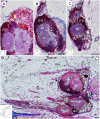Neuroanatomy of a hydrothermal vent shrimp provides insights into the evolution of crustacean integrative brain centers
- PMID: 31383255
- PMCID: PMC6684273
- DOI: 10.7554/eLife.47550
Neuroanatomy of a hydrothermal vent shrimp provides insights into the evolution of crustacean integrative brain centers
Abstract
Alvinocaridid shrimps are emblematic representatives of the deep hydrothermal vent fauna at the Mid-Atlantic Ridge. They are adapted to a mostly aphotic habitat with extreme physicochemical conditions in the vicinity of the hydrothermal fluid emissions. Here, we investigated the brain architecture of the vent shrimp Rimicaris exoculata to understand possible adaptations of its nervous system to the hydrothermal sensory landscape. Its brain is modified from the crustacean brain ground pattern by featuring relatively small visual and olfactory neuropils that contrast with well-developed higher integrative centers, the hemiellipsoid bodies. We propose that these structures in vent shrimps may fulfill functions in addition to higher order sensory processing and suggest a role in place memory. Our study promotes vent shrimps as fascinating models to gain insights into sensory adaptations to peculiar environmental conditions, and the evolutionary transformation of specific brain areas in Crustacea.
Keywords: Rimicaris exoculata; brain; hydrothermal vent; neuroscience; shrimp.
© 2019, Machon et al.
Conflict of interest statement
JM, JK, RM, MZ, JR, NM, TC, SH No competing interests declared
Figures












Comment in
-
Adaptations to extreme conditions.Elife. 2019 Aug 30;8:e50647. doi: 10.7554/eLife.50647. Elife. 2019. PMID: 31469073 Free PMC article.
References
-
- Ache BW. Crustaceans as animal models for olfactory research. In: Wiese K, editor. Crustacean Experimental Systems in Neurobiology. Berlin: Springer; 2002. pp. 189–199. - DOI
-
- Blaustein DN, Derby CD, Simmons RB, Beall AC. Structure of the brain and medulla terminalis of the spiny lobster Panulirus argus and the crayfish Procambarus clarkii, with an emphasis on olfactory centers. Journal of Crustacean Biology. 1988;8:493–519. doi: 10.2307/1548686. - DOI
Publication types
MeSH terms
Grants and funding
LinkOut - more resources
Full Text Sources

